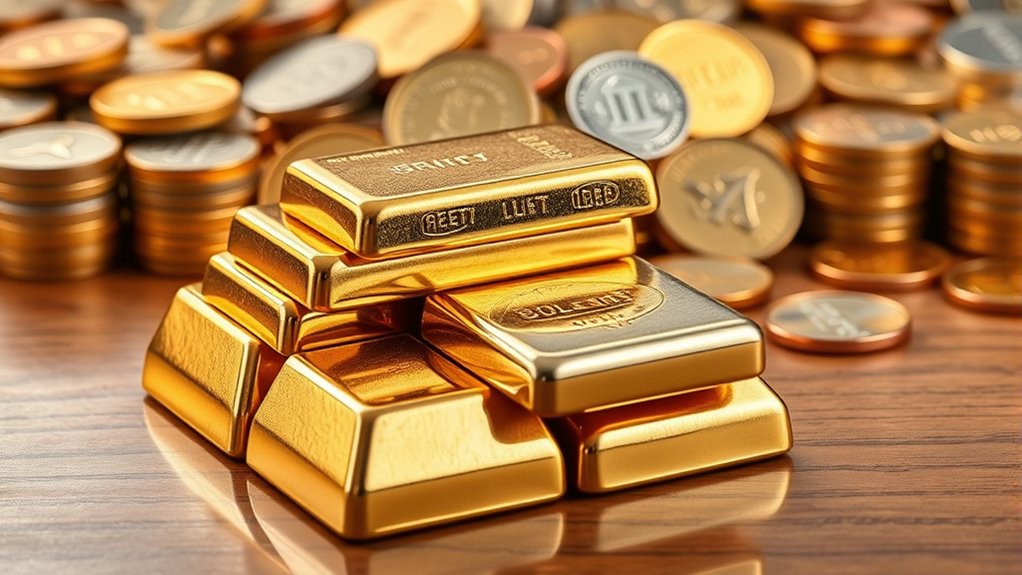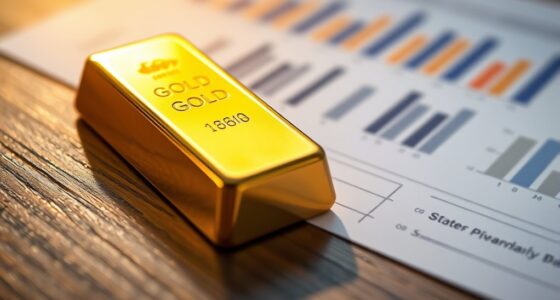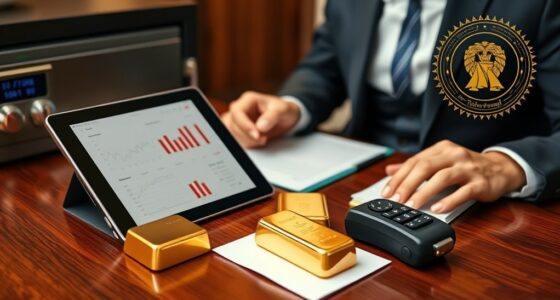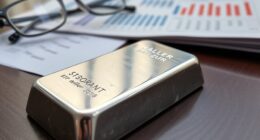Experts recommend allocating about 5–15% of your investment portfolio to precious metals. This range offers a good balance between diversification and risk management, helping to protect your assets during economic downturns or inflation. Keep in mind your risk tolerance, goals, and investment horizon when deciding. If you’re interested in optimizing your portfolio further and understanding how to effectively incorporate metals, there’s more to weigh below.
Key Takeaways
- Most financial advisors recommend allocating 5-15% of your portfolio to precious metals.
- Smaller allocations offer diversification benefits without excessive risk exposure.
- Consider your risk tolerance, investment horizon, and financial goals when deciding allocation.
- Precious metals can reduce overall volatility and act as a hedge during market downturns.
- Balance potential inflation protection against costs and market volatility for optimal diversification.

Diversifying with precious metals can be a smart way to strengthen your investment portfolio. By spreading your investments across different asset classes, you reduce the risk of significant losses if one area underperforms. Precious metals, such as gold, silver, platinum, and palladium, are especially appealing because they tend to have a low or even negative correlation with traditional assets like stocks and bonds. This means that when equities decline, metals often hold their value or even increase, providing a valuable buffer during market downturns.
Each metal has its unique characteristics and market drivers. Gold is widely regarded as a safe haven and a reliable store of value, especially during periods of economic instability or currency devaluation. Silver, while also a precious metal, is heavily influenced by industrial demand, which can cause its price to fluctuate more sharply. Platinum and palladium are primarily used in industrial applications like automotive catalysts, so their prices can be affected by changes in industry demand and supply. You can choose to invest in physical metals—bars or coins—or opt for financial instruments such as ETFs or futures contracts, depending on your risk tolerance and investment strategy.
Gold is a safe haven; silver, platinum, and palladium are industrially driven, influencing their prices and investment strategies.
Historically, precious metals have shown stability over centuries, often acting as a safeguard in tough economic times. They are considered a hedge against inflation, with gold particularly known for preserving purchasing power during rising prices. Silver also offers some inflation protection, especially when industrial use increases. Additionally, metals are viewed as safe-haven assets that tend to appreciate during market shocks or geopolitical crises, offering downside protection. Physical metals do not carry counterparty risk because they are not tied to any financial institution’s solvency. They are also highly liquid—gold and silver can be bought or sold easily globally, providing quick access to cash when needed. Including metals in your portfolio can reduce overall volatility, acting as insurance against downturns in other investments.
However, owning physical metals involves storage and insurance costs, which add to your total ownership expenses. Prices can be volatile in the short term, influenced by global demand, mining output, and macroeconomic conditions. Unlike stocks or bonds, metals do not generate dividends or interest, so they might lag in total returns during strong bull markets for risk assets. Industrial demand heavily influences silver, platinum, and palladium prices, leading to potential volatility unrelated to investment motives. Additionally, legal and tax considerations may affect your ownership and sale of metals depending on your jurisdiction. The global demand for precious metals also fluctuates based on economic trends, impacting their market prices. Most financial advisors recommend allocating about 5–15% of your portfolio to precious metals. The exact percentage depends on your risk appetite, investment horizon, and overall financial goals. A smaller allocation can provide diversification benefits without overly exposing you to the market swings of metals. As you consider this allocation, weigh the benefits of downside protection and inflation hedging against the costs and risks associated with physical ownership and market fluctuations. Properly balancing your portfolio with precious metals can help you better navigate economic uncertainties and enhance your overall investment resilience.
Frequently Asked Questions
How Do Precious Metals Compare to Other Alternative Investments?
Precious metals offer a unique hedge against inflation and economic instability compared to other alternative investments. You can easily liquidate them and they tend to hold value during turbulent times. Unlike real estate or cryptocurrencies, metals like gold and silver are tangible assets with a long history of preserving wealth. While they might not generate income, they provide diversification, reducing overall portfolio risk and offering stability when markets fluctuate.
What Are the Tax Implications of Investing in Precious Metals?
When you invest in precious metals, you’ll face specific tax implications. Gains are typically taxed as collectibles, which means higher capital gains rates, often up to 28%. You must report any profits on your tax return, and losses can offset gains. Keep detailed records of your purchases and sales to guarantee accurate reporting. Consulting a tax professional helps you understand how these taxes apply to your specific situation.
Should I Buy Physical Metals or Invest in ETFS?
You should consider buying physical metals if you want direct ownership and tangible assets, which can serve as a hedge during economic instability. On the other hand, ETFs offer liquidity, ease of trading, and lower costs, making them ideal for passive investors. Your choice depends on your goals, risk tolerance, and whether you prefer holding physical assets or more convenient, diversified investment options.
How Often Should I Rebalance My Precious Metals Portfolio?
Oh, because your precious metals portfolio is obviously a living, breathing creature—how could you not want to check in regularly? You should rebalance at least once a year, or whenever your assets drift markedly from your target allocation. If gold suddenly skyrockets, you might need to sell some. Keep an eye on market shifts, and don’t let your shiny assets become a wild, unruly pet.
What Are the Risks Associated With Precious Metals Investing?
You face risks like market volatility, which can cause prices to fluctuate unexpectedly, and economic downturns that might reduce demand. There’s also the risk of theft or loss if you don’t store your metals securely. Additionally, precious metals don’t generate income like dividends or interest, and their value can be affected by currency changes and geopolitical tensions. Be aware of these factors to manage your investment wisely.
Conclusion
So, if you want your portfolio to be as unstoppable as a superhero saving the world, diversifying with precious metals is your secret weapon. Just a small allocation could turn your investments into an impenetrable fortress against market chaos. Don’t wait for a financial apocalypse—start adding gold and silver today, and watch your wealth grow stronger than a superhero’s shield. Remember, a little sparkle now can save your financial future from total disaster!









